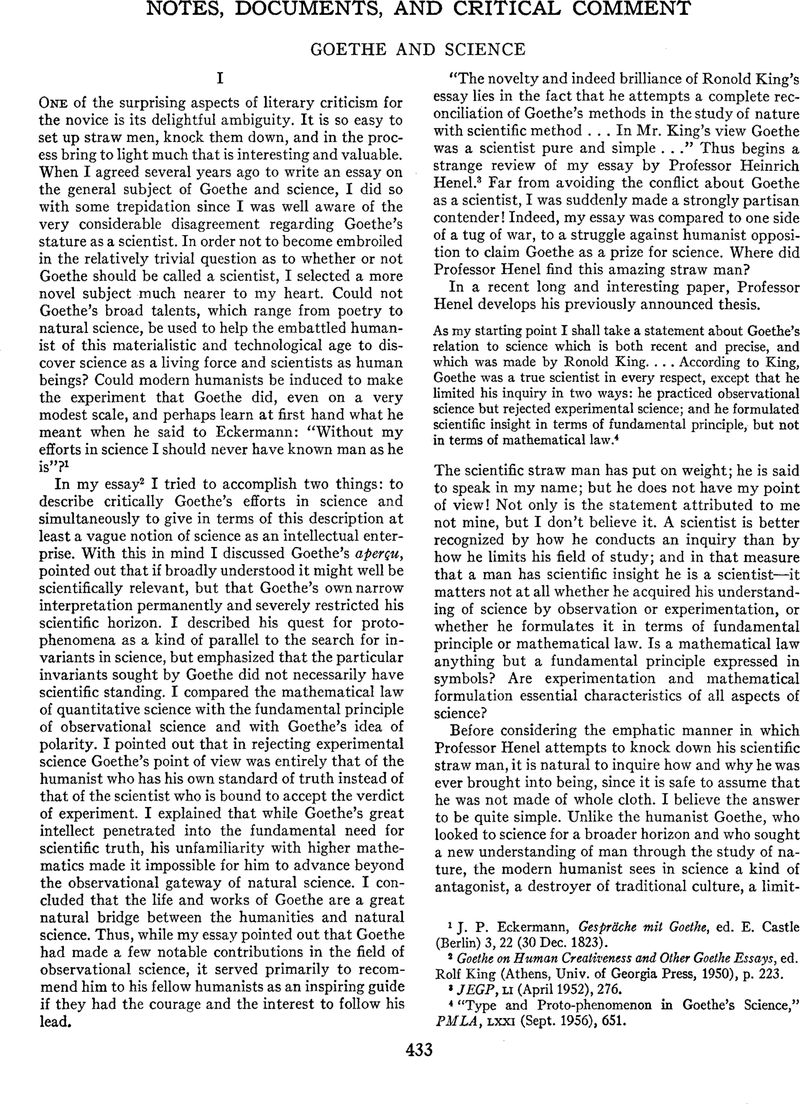No CrossRef data available.
Article contents
Goethe and Science
Published online by Cambridge University Press: 02 December 2020
Abstract

- Type
- Notes, Documents, and Critical Comment
- Information
- Copyright
- Copyright © Modern Language Association of America, 1958
References
Note 1 in page 433 J. P. Eckermann, Gespr'dche mit Goethe, ed. E. Castle (Berlin) 3, 22 (30 Dec. 1823).
Note 2 in page 433 Goethe on Human Creativeness and Other Goethe Essays, ed. Rolf King (Athens, Univ. of Georgia Press, 1950), p. 223.
Note 3 in page 433 JEGP, Li (April 1952), 276.
Note 4 in page 433 “Type and Proto-phenomenon in Goethe's Science,” PMLA, LXXI (Sept. 1956), 651.
Note 5 in page 434 “Goethe, Idealistic Morphology, and Science,” American Scientist, XL (April 1952), 313.
Note 6 in page 434 For a more detailed and comprehensive discussion of this dynamic definition of science see, e.g., J. B. Conant, Science and Common Sense (New Haven: Yale Univ. Press, 1951).
Note 7 in page 435 “Type and Proto-phenomenon in Goethe's Science,” pp. 652, 658, 668.
Note 8 in page 435 Wolff, “What Hope Does for Man,” Sat. Rev., 5 Jan. 1957, p. 42.
Note 9 in page 435 Wilhelm Meister's Journeyings iii, 1 (1829), 19, 27.
Note 10 in page 436 “The Problem of Form in Present-Day Botany,” Phyto-morphology, p (Dec. 1952), 215-224.
Note 11 in page 436 Bloch, n. 5. above.
Note 1 in page 437 The word Essay or the letter ? designates the article by Remold King, “Goethe and the Challenge of Science in Western Civilization,” in Goethe on Human Creativeness and Other Goethe Essays, ed. Rolf King (Athens: Univ. of Georgia Press, 1950), pp. 223-252. The word Criticism or the letter C designates the article by Prof. King which precedes this reply. Numerals following ? and C are page references; C page numbers of course refer to the present issue of PMLA.
Note 2 in page 437 Prof. King's italics here and in all subsequent quotations. 3 Mary B. Hesse, Science and the Human Imagination (London, 1954), p. 36.
Note 4 in page 438 Quoted in Charles Sherrington, Goethe on Nature and on Science, 2nd ed. (Cambridge, Eng., 1949), p. 45.
Note 5 in page 438 “Goethes Metamorphose der Pflanzen,” Goethe ah Seher und Erforscher der Natur, ed. Johannes Walther (Halle, 1930), pp. 205-226.
Note 6 in page 438 Wilhelm Troll, Goethes morphologische Schriften, Neue Sonderausgabe (Jena, 1932), p. 101.
Note 7 in page 438 Agnes Arber, “Goethe's Botany,” Chronica Botanica, x, ii (Summer 1946), 63-126.
Note 8 in page 439 The History of Biology, new ed. (New York, 1935), p. 282.
Note 9 in page 439 “Goethe, Idealistic Morphology, and Science,” American Scientist, XL, ii(April 1952), 313-322.
Note 10 in page 439 Bloch's position is further characterized by his favorable review of Erich Heller's The Disinherited Mind (American Scientist, XLI, iv [Oct. 1953], 619-622). The opening essay of Heller's book is a discussion of Goethe's relation to science which would give Prof. King much more cause for complaint than my article.
Note 11 in page 440 “Die Goethe'sche und die Newton'sche Farbenlehre im Lichte der modernen Physik,” Geist der Zeit, xix, ? (May 1941), 261-275.
Note 12 in page 440 Quoted in Martin Dyck, “Goethe's Views on Pure Mathematics,” Germanic Review, xxxi, i (Feb. 1956), 68.
Note 13 in page 441 Nachwort zu Goethes Werke, Hamburger Ausgabe, xiii (1955), 537-554.
Note 14 in page 442 Science and the Common Understanding (New York, 1953), pp. 21 f.
Note 15 in page 442 Maximen und Reflexionen, ed. Giinther Millier, 3rd ed. (Stuttgart, 1949), No. 1263.
Note 16 in page 442 Pages 270-275 (see n. 11 above).


